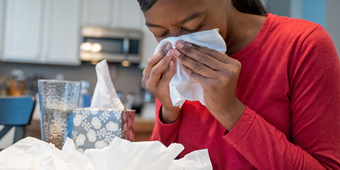6 Symptoms That Can Signal Lung Disease

Answer a few questions and we'll provide you with a list of primary care providers that best fit your needs.
Breathing is something you probably don’t think much about — even though you do it about 25,000 times a day. Every breath you take helps deliver oxygen from your lungs to your bloodstream.
But it’s a different story if you have lung disease. The number of U.S. women diagnosed with lung disease is rising. And more women are dying of lung diseases.
Symptoms can mimic a cold or allergies, so staying alert to the warning signs can help you detect and treat problems early.
The number of U.S. women diagnosed with lung disease is rising. And more women are dying of lung diseases.
What Are the Different Types of Lung Disease?

Lung disease refers to many disorders that affect the lungs. When you have lung disease, your body may not get enough oxygen. The most common lung diseases in women include:
- Asthma, a chronic (ongoing) disease of bronchial tubes, airways that carry air in and out of the lungs. When you have asthma, the airways become inflamed, or swollen, and highly sensitive. They overreact to smoke, air pollution, mold, chemical sprays and other irritants.
The airways can be irritated by common allergens like pollen and dust mites, and by simple respiratory infections such as a cold. When this happens, the airways get narrower, making breathing more difficult.
- Chronic obstructive pulmonary disease (COPD), which refers to two conditions, chronic bronchitis and emphysema. They often occur together. Both make breathing difficult, and usually worsen over time.
With chronic bronchitis, the airways are irritated and make extra mucus, leading to lots of coughing. Over time, the airways become scarred, limiting airflow to and from the lungs.
With emphysema, the lung tissue is weakened, and the walls of the air sacs break down. This means less oxygen enters the blood, causing shortness of breath, wheezing and coughing.
- Lung cancer causes abnormal (malignant) lung cells to multiply and grow uncontrolled. These cancerous cells can invade nearby tissues, spread to other parts of the body, or both. There are two major kinds of lung cancer: small cell and non-small cell. Most lung cancers are non-small cell, which spreads more slowly than small cell.
Air pollution and allergens may play a role in these diseases. And a preventable risk factor is clearly involved — tobacco use. If you smoke, quit. If someone close to you does, ask them to take their cigarette breaks outdoors. Even secondhand smoke is damaging.
What Are the Warning Signs of Lung Disease?
Early signs of lung disease are easy to overlook. Knowing the warning signs can help you get treatment before the condition becomes serious. If you have any of these symptoms, make an appointment with your health care provider:
- Trouble breathing or shortness of breath: It’s not normal to have shortness of breath for no reason, or that doesn’t go away after exercise.
- Feeling like you’re not getting enough air: Labored breathing, when it’s hard to breath in and out, is a warning sign of trouble.
- Chronic cough: Coughing for more than a month, may be a signal that something is wrong with your respiratory system.
- Coughing up blood: The blood may be coming from your lungs or upper respiratory tract, signaling a health problem.
- Chronic mucus production: Mucus can defend against infections or irritants. But increased mucus production for more than a month could indicate lung disease.
- Chronic chest pain: Unexplained chest pain that lasts for more than a month, and worsens when you breathe in or cough, is a warning sign.
Answer a few questions and we'll provide you with a list of primary care providers that best fit your needs.
Source: WomensHealth.gov; American Lung Association; MedlinePlus




